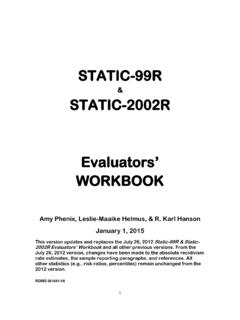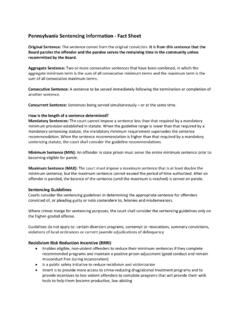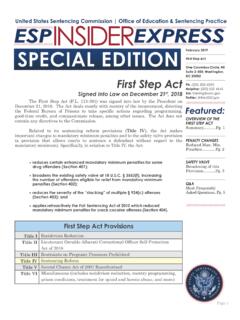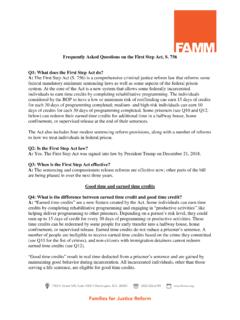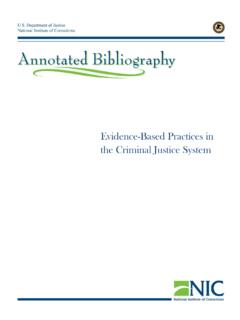Transcription of Static-99R Coding Rules Revised 2016
1 1 Static-99R Coding Rules Revised 2016 Amy Phenix, Yolanda Fernandez, Andrew J. R. Harris, Maaike Helmus, R. Karl Hanson, & David Thornton In-Press Version (14-NOV- 2016 ) 2 2 Table of Contents How To Use This Manual .. 4 Introduction .. 6 Introduction to 6 Missing Items .. 7 recidivism Criteria .. 7 Non-Contact Sex Offences .. 7 Training .. 8 Treatment .. 8 Self-Report and Static-99R .. 8 Inter-Rater Reliability of Static-99R .. 9 Revised Risk Levels .. 11 Whom Can You Use Static-99R On? .. 12 Time Offence-Free in the Community After Release from the Index Sex Offence .. 13 Static-99R When the Current Offence is Not a Sexually Motivated Offence .. 14 Static-99R with Adolescents who Sexually 14 Static-99R with Offenders Who are Developmentally Delayed.
2 15 Static-99R with Institutionalized Offenders .. 15 Static-99R with Offenders who Aid in a Sex Offence .. 15 Static-99R with Non-Caucasian Sex Offenders .. 16 Static-99R and Offenders with Mental Health Issues .. 16 Static-99R and Gender Transformation .. 16 Information Required to Score Static-99R .. 18 Polygraph Information .. 18 Standards of Proof and Coding Static-99R .. 19 Definitions .. 20 Sex Offence .. 20 Category A and Category B Offences .. 21 Probation, Parole or Conditional Release Violations as Sex Offences .. 25 Institutional Rule Violations .. 26 What Counts as a Conviction/Sentencing Date Versus a Charge .. 28 Conviction/Sentencing Date .. 28 Determining Whether Something is a Conviction .. 29 Probation, Parole, or Conditional Release Violation.
3 29 Charges .. 36 Situations That Do Not Count as Charges OR Convictions .. 37 Index Sex Offence .. 38 Offence Clusters, Pseudo- recidivism , Historical Offences, and Prior Offences .. 38 Historical Offences .. 38 Index Cluster .. 38 Pseudo- recidivism .. 40 3 3 Post-Index Offences .. 40 Prior Offence(s) .. 41 Separating Index Clusters and Prior Offences .. 42 Scoring the 10 45 Item # 1 Age at Release from Index Sex Offence .. 46 Item # 2 Ever Lived with an Intimate Partner 2 Item # 3 Index Non-Sexual Violence (NSV) Any Convictions .. 52 Item # 4 Prior Non-Sexual Violence Any Convictions .. 58 Item # 5 Prior Sex Offences .. 63 Item # 6 Prior Sentencing Dates .. 68 Item # 7 Any Convictions for Non-Contact Sex Offences .. 70 Items #8, #9, & # 10 The Three Victim Questions.
4 74 Item # 8 Any Unrelated Victims? .. 79 Item # 9 Any Stranger Victims? .. 82 Item # 10 Any Male Victims? .. 84 Scoring Static-99R & Computing the Risk Estimates .. 85 Appendix A: 86 Appendix B: References .. 88 Appendix C: Static-99R Coding Form and Comments .. 93 4 How To Use This Manual This manual comprises the third published version of the static -99, and now Static-99R , Coding Rules (previous versions: Hanson & Thornton, 1999; Harris, Phenix, Hanson, & Thornton, 2003). Each Coding Manual has been designed to provide greater detail and a more comprehensive review of how to code static -99 and Static-99R . This is the first set of Coding Rules designed for the Revised version: Static-99R . The Static-99R Coding Rules are designed to be used in all jurisdictions where Static-99R is scored.
5 We recommend that evaluators using static -99 should switch to Static-99R (Helmus, Thornton, Hanson, & Babchishin, 2012). If, however, evaluators still use static -99 (for example, following legal or administrative requirements), these Coding Rules should be applied to static -99 as well (with the exception that the age weights differ between static -99 and Static-99R ). Additionally, those using static -99 should not report the recidivism norms from the 2003 Coding Manual as they are outdated and obsolete and should not be used in forensic evaluations or considered in applied decisions (instead, see Helmus, Hanson, & Thornton, 2009). Although the 2009 norms are not ideal, they are preferable to the 2003 norms. In particular though, the 2009 static -99 norms should not be used for offenders who are aged 60 or older at release, as they have been found (Helmus, Thornton et al.)
6 , 2012) to substantially overestimate risk of recidivism (or if an evaluator is legally required to use them, they should note that it is an overestimate). In most cases, scoring Static-99R is fairly straightforward for an experienced evaluator. If you are unfamiliar with this instrument, we suggest that you turn to the back pages of this manual and find the one-page Static-99R Coding Form. You may want to keep a copy of this to one side as you review the manual. The purpose of the scoring manual is to provide all information necessary to score the items and produce a total Static-99R score, with some additional context on the appropriate uses of the scale. For information on how to interpret and report the score results (including both relative and absolute risk information), the reader is referred to the Evaluators' Handbook (Phenix, Helmus, & Hanson, 2016 ) available at , in the section labelled Norms.
7 The handbook is updated periodically to incorporate advances in research, and evaluators are encouraged to check that their reports are based on the most recent version. The reason the Coding Rules and the workbook are in separate documents is that we expect updated research will require frequent updates to the latter, but not the former. Although this version of the Coding manual has non-trivial changes from the previous (2003) version which will result in different scorings for a small number of cases, we do not anticipate that these changes require re-calibration of the normative data for the scale. In other words, the existing Evaluator Workbook for Static-99R (Phenix et al., 2016 ) is still applicable. It is always possible, nonetheless, that future research will identify improvements to the normative data.
8 We strongly recommend you familiarize yourself with the entirety of the Coding Rules before scoring the instrument. We understand there is repetition in this manual and some material will be more pertinent than other sections. The Coding manual has two broad sections. The first section has a lot of introductory and background material, as well as global recommendations on when/how to use the scale, including information on: - Training - Treatment - Self-report information - Inter-rater reliability 5 - Who can you use Static-99R on -Time offence-free in the community after release from the index sex offence - When the current offence is not sexually motivated - Static-99R for offenders who are juveniles, developmentally delayed, institutionalized, who aided in a sex offence, are non-Caucasian, have mental health issues, or have undergone gender transformation - Information required to score Static-99R - Definitions for key concepts such as sex offence (including Category A versus Category B offences), charges, convictions/sentencing dates, offence clusters, pseudo- recidivism , and historical offences.
9 The second main section of the manual begins at the section entitled Scoring the Ten Items on page 45. This section provides the specific Rules required to score each item. For each of the ten items, the Coding instructions begin with three pieces of information: The Basic Principle, Information Required to Score this Item, and The Basic Rule. The following sections for each item provide fuller explanations of the item along with how the Rules are intended to apply to unusual or difficult scoring cases, as well as how special circumstances affect the scoring and exclusions that may apply. Users should ensure that they are familiar with this more detailed guidance so they more fully understand the item and they know when to refer to it to resolve scoring difficulties.
10 Often just reading these three small sections will allow you to score that item on Static-99R . The following sections for each item describe special circumstances or exclusions that may apply to your case. This expanded version of Static-99R Coding contains much information that is related to specific uses of the Static-99R in unusual circumstances and many sections of this manual need only be referred to in exceptional circumstances or as occasional reminders. We also suggest that you briefly review the three appendices as they contain a self-test resource, helpful references, and the Static-99R Coding Form (pages 86 to 94). If you find that you have a Coding question not addressed in this manual, you can direct the question to or at the website, Please consult the Coding manual and FAQs on the website prior to submission of questions.







